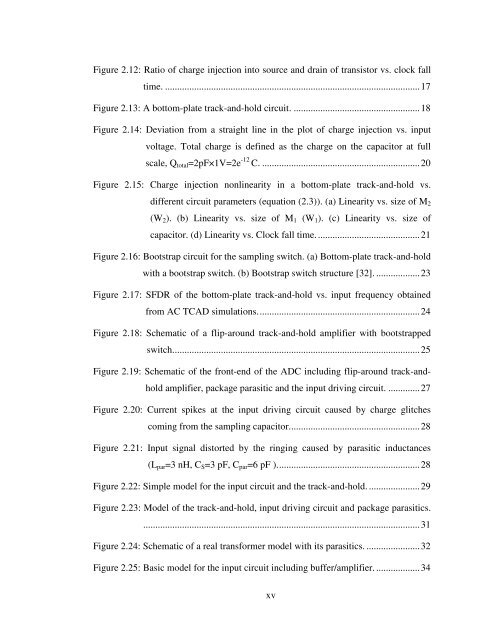digital compensation of dynamic acquisition errors at the front-end of ...
digital compensation of dynamic acquisition errors at the front-end of ...
digital compensation of dynamic acquisition errors at the front-end of ...
Create successful ePaper yourself
Turn your PDF publications into a flip-book with our unique Google optimized e-Paper software.
Figure 2.12: R<strong>at</strong>io <strong>of</strong> charge injection into source and drain <strong>of</strong> transistor vs. clock fall<br />
time. .........................................................................................................17<br />
Figure 2.13: A bottom-pl<strong>at</strong>e track-and-hold circuit. ....................................................18<br />
Figure 2.14: Devi<strong>at</strong>ion from a straight line in <strong>the</strong> plot <strong>of</strong> charge injection vs. input<br />
voltage. Total charge is defined as <strong>the</strong> charge on <strong>the</strong> capacitor <strong>at</strong> full<br />
scale, Q total =2pF×1V=2e -12 C. .................................................................20<br />
Figure 2.15: Charge injection nonlinearity in a bottom-pl<strong>at</strong>e track-and-hold vs.<br />
different circuit parameters (equ<strong>at</strong>ion (2.3)). (a) Linearity vs. size <strong>of</strong> M 2<br />
(W 2 ). (b) Linearity vs. size <strong>of</strong> M 1 (W 1 ). (c) Linearity vs. size <strong>of</strong><br />
capacitor. (d) Linearity vs. Clock fall time. ..........................................21<br />
Figure 2.16: Bootstrap circuit for <strong>the</strong> sampling switch. (a) Bottom-pl<strong>at</strong>e track-and-hold<br />
with a bootstrap switch. (b) Bootstrap switch structure [32]. ..................23<br />
Figure 2.17: SFDR <strong>of</strong> <strong>the</strong> bottom-pl<strong>at</strong>e track-and-hold vs. input frequency obtained<br />
from AC TCAD simul<strong>at</strong>ions...................................................................24<br />
Figure 2.18: Schem<strong>at</strong>ic <strong>of</strong> a flip-around track-and-hold amplifier with bootstrapped<br />
switch......................................................................................................25<br />
Figure 2.19: Schem<strong>at</strong>ic <strong>of</strong> <strong>the</strong> <strong>front</strong>-<strong>end</strong> <strong>of</strong> <strong>the</strong> ADC including flip-around track-andhold<br />
amplifier, package parasitic and <strong>the</strong> input driving circuit. .............27<br />
Figure 2.20: Current spikes <strong>at</strong> <strong>the</strong> input driving circuit caused by charge glitches<br />
coming from <strong>the</strong> sampling capacitor......................................................28<br />
Figure 2.21: Input signal distorted by <strong>the</strong> ringing caused by parasitic inductances<br />
(L par =3 nH, C S =3 pF, C par =6 pF )...........................................................28<br />
Figure 2.22: Simple model for <strong>the</strong> input circuit and <strong>the</strong> track-and-hold. .....................29<br />
Figure 2.23: Model <strong>of</strong> <strong>the</strong> track-and-hold, input driving circuit and package parasitics.<br />
..................................................................................................................31<br />
Figure 2.24: Schem<strong>at</strong>ic <strong>of</strong> a real transformer model with its parasitics. ......................32<br />
Figure 2.25: Basic model for <strong>the</strong> input circuit including buffer/amplifier. ..................34<br />
xv
















